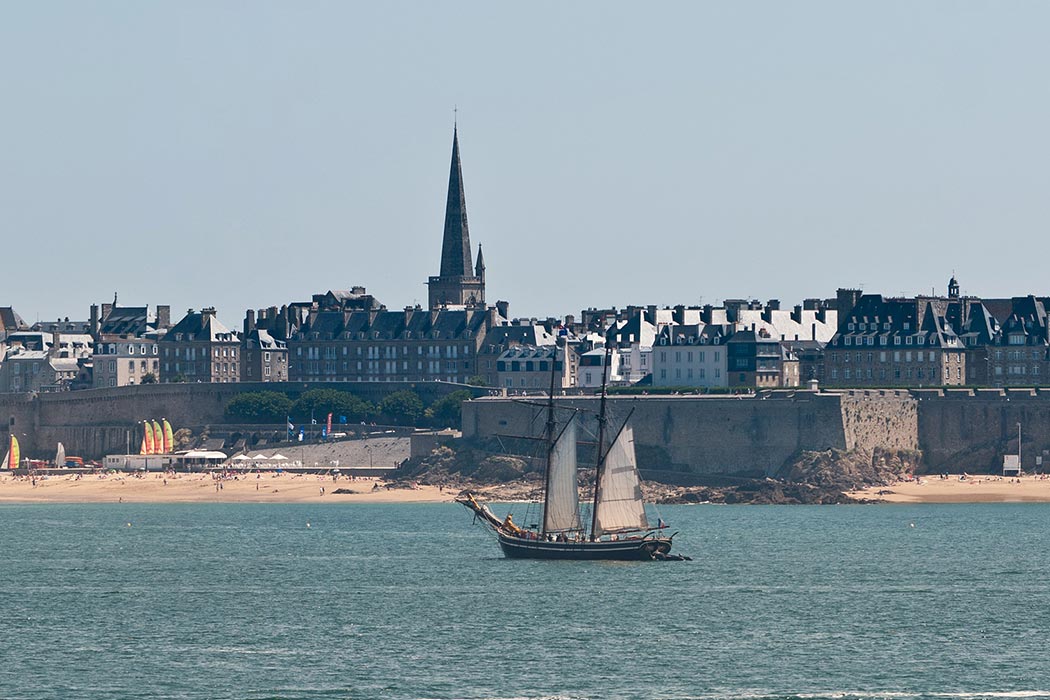From windsurfing on the waves to sunbathing on the beach to swimming in the frigid English Channel, it’s easy to get caught up in the outdoor activities the French town of Saint Malo has to offer. There’s even a transatlantic race that departs from Saint Malo every four years, which sees sailors retrace the “Route du Rhum.” But Saint Malo is much more than a coastal town with fresh air and scenic views. The Corsair City has sheltered scoundrels and villains for much of its history, including pirates, cod smugglers, and even Nazis.
The buildings that have survived the test of time are visible reminders of all the city has been through. They’re also a sort of disguise: to the untrained viewer, it seems as if all is equally ancient. But much is new, reconstructed over the bones of ruined buildings. The visible history and hidden modernity make the city a place of contrast, full of hidden cracks to be explored by the active imagination. As writer Anthony Doerr said of his first encounter of the city, which would become the setting for his novel All the Light We Cannot See: “I felt as if I was walking through a city plucked from the imagination of Italo Calvino, a place that was part fairy-tale castle, part M. C. Escher drawing, part mist and ocean wind and lamplight.”
The history of the walled medieval city of Saint Malo stretches back for centuries and includes political intrigue, brief declarations of independence, and plenty of seafaring. One of the earliest of its famous mariners was Jacques Cartier, who lead a voyage to North America in 1534. His three expeditions along the St. Lawrence River allowed France to lay claim to the territory that later became known as Canada. The first voyage from Saint Malo to Newfoundland took only 20 days, and Cartier took his men as far as Anticosti Island on that first trip, paving the way for later French exploration further into the interior.
But Cartier’s expedition was only the start of the seafaring tradition, and by the 18th century, the walled town had a reputation for its fearsome corsairs, who pillaged non-French ships crossing the English Channel and Atlantic. The town was known by British mariners as the “Hornet’s Nest,” a name alluding to its treacherous coastline and fleet of well-trained sailors. One of the most infamous of these privateers was Robert Surcouf, said to have single-handedly killed 11 men in a duel.
When they weren’t stealing goods or gold from cargo-laden ships from the Caribbean, the wily Malouins resorted to stealing salted codfish. The preserved fish were immensely popular across Europe, and especially in Spain. Unfortunately for France, however, Spanish consumers seemed to prefer British dry cod to the French version, perhaps because the British used Spanish salt to preserve it. The majority of Spanish merchants bought dry cod from British ships – until the two countries went to war in 1739. With prices for dry cod plummeting in Britain and soaring in Spain, a few opportunistic merchants from Saint Malo found ways to make the most of the booming market. Lead by the four Chenu brothers, merchant vessels out of Saint Malo set up renegade fishing settlements in southwestern Newfoundland. They took English cod and pretended it was French; they acquired English cod from the English Channel Islands and passed it off as French; and sometimes they changed the nationality of ships from English to French before heading into Spain to trade the fish. One official bemoaned the situation, saying, “The Bretons are the only ones who engage in this without scruple.”
With such colorful characters splashed across the pages of the town’s past, it’s no wonder the Malouins worked hard to preserve the history of their home. But everything changed when war broke out in 1939. Saint Malo was occupied by German soldiers for four years, who didn’t leave until late in the summer of 1944. Over the course of July and August 1944, extensive Allied bombing and German shelling caused the near-total destruction of the city. Wood-framed houses were swallowed by fire, and granite mansions were blown apart. Of the 865 buildings inside the city walls, 683 were destroyed, resulting in the loss of 2,000 dwellings. “Ruins had to be made safe or demolished; debris had to be cleared; recyclable building materials needed stockpiling; mines had to be removed; and temporary housing provided for the emergency workforce,” writes scholar Hugh Clout.
Miraculously, the city came back together in less than a decade. Construction that began in 1955 was completed by 1960, including the rebuilding of 90 percent of the original structures – with wider streets, improved sunlight penetration, and better air circulation. All the buildings were made using local granite for the exterior walls (though concrete could be used on the interior), and the roofs were made of slates from the Monts d’Arrée. The final touch was a new spire for the city’s cathedral, put in place in 1971.
Despite the bombings the city endured, and despite the construction required to raise it from the ashes, Saint Malo’s deep sense of history remains imbued in the very stones beneath the buildings. Even after great destruction, a city can retain the essence of its soul – for all that its population and its streets have changed. As Doerr writes in All the Light We Cannot See: “The Goddess of History looked down to earth. Only through the hottest fires can purification be achieved.”







